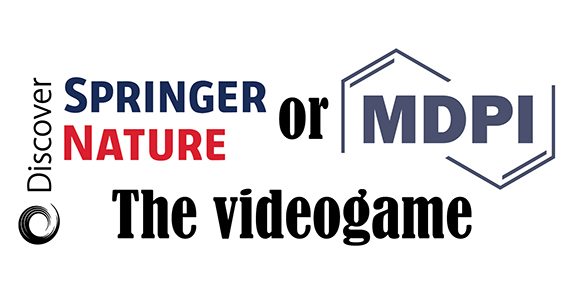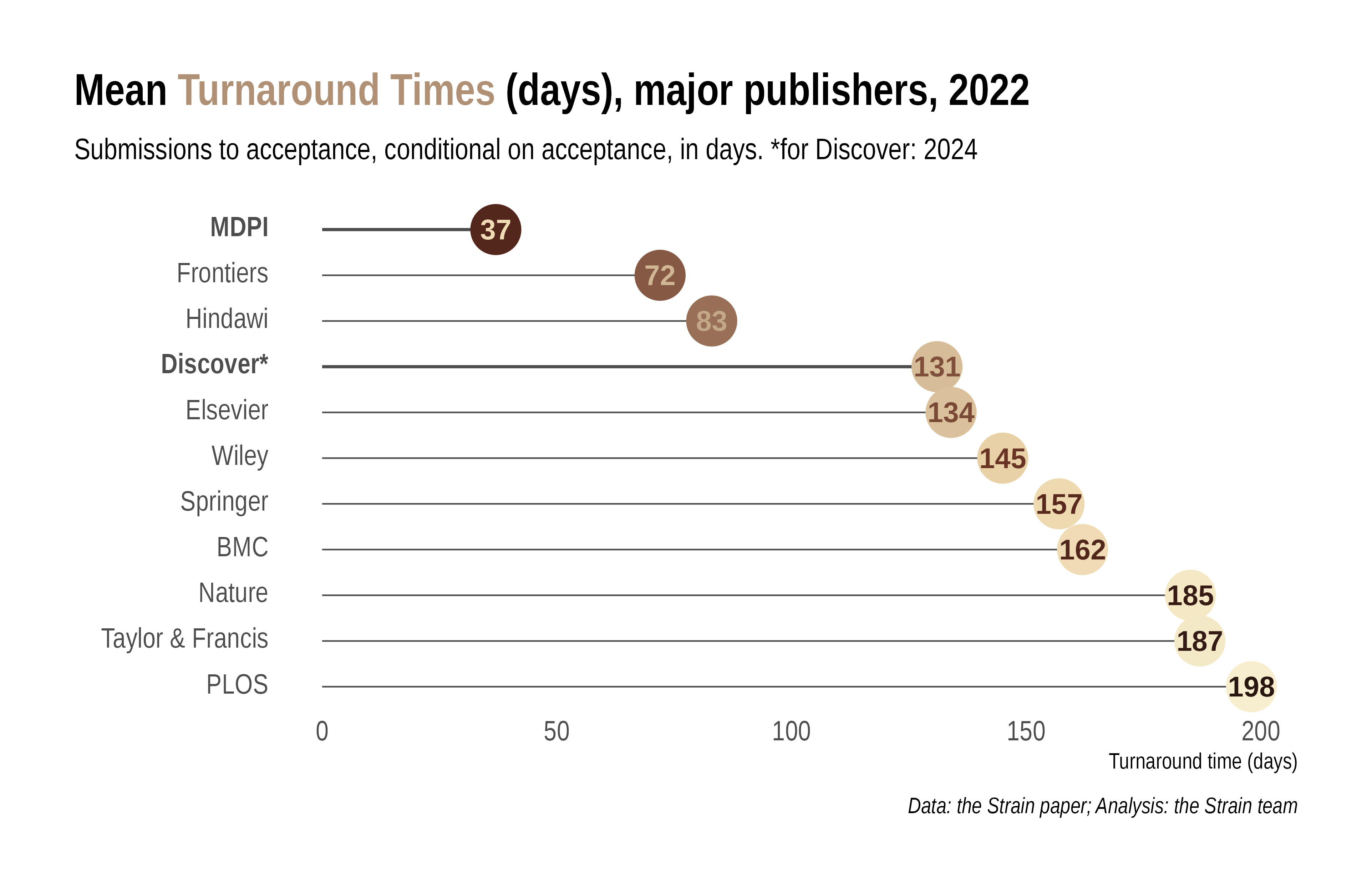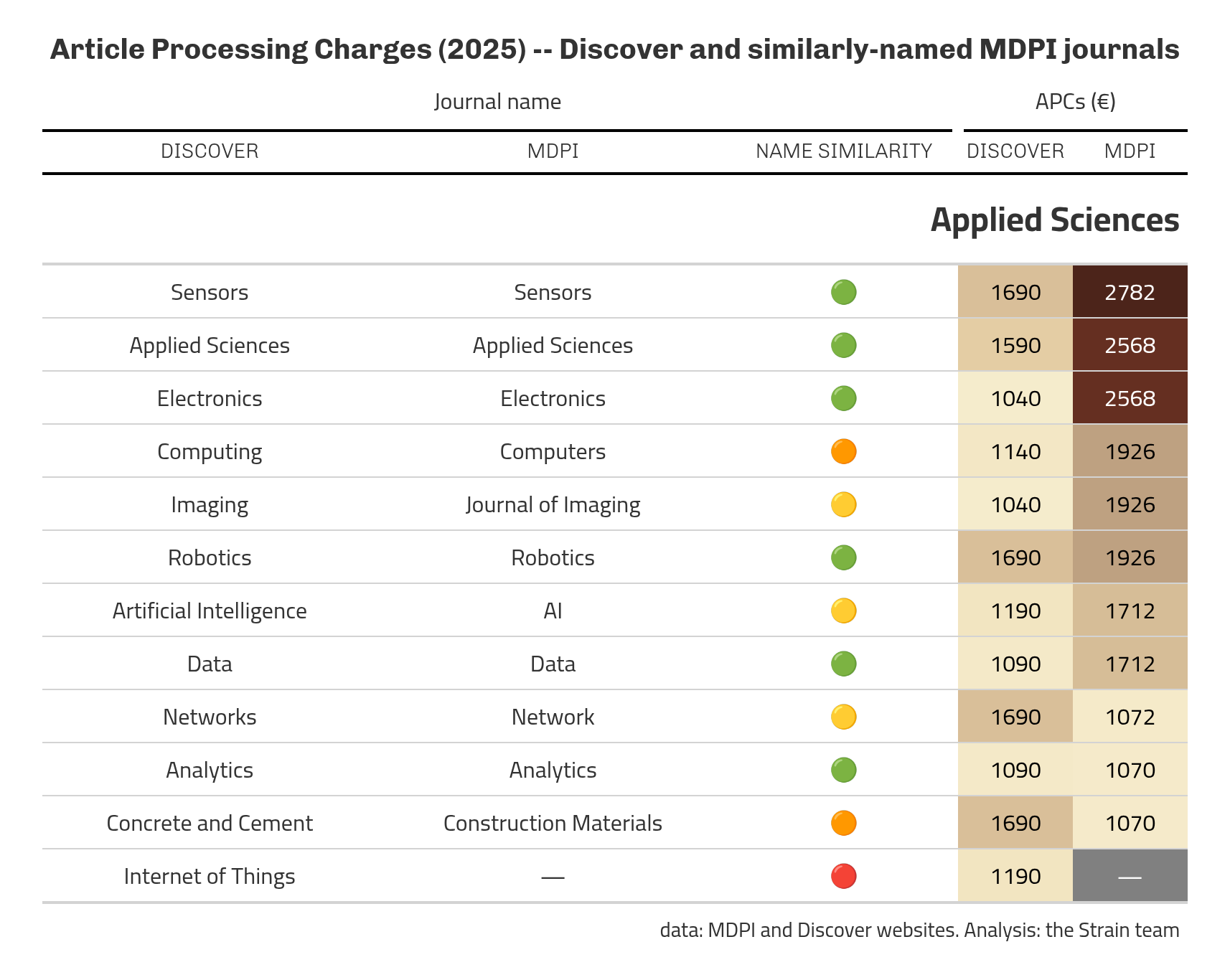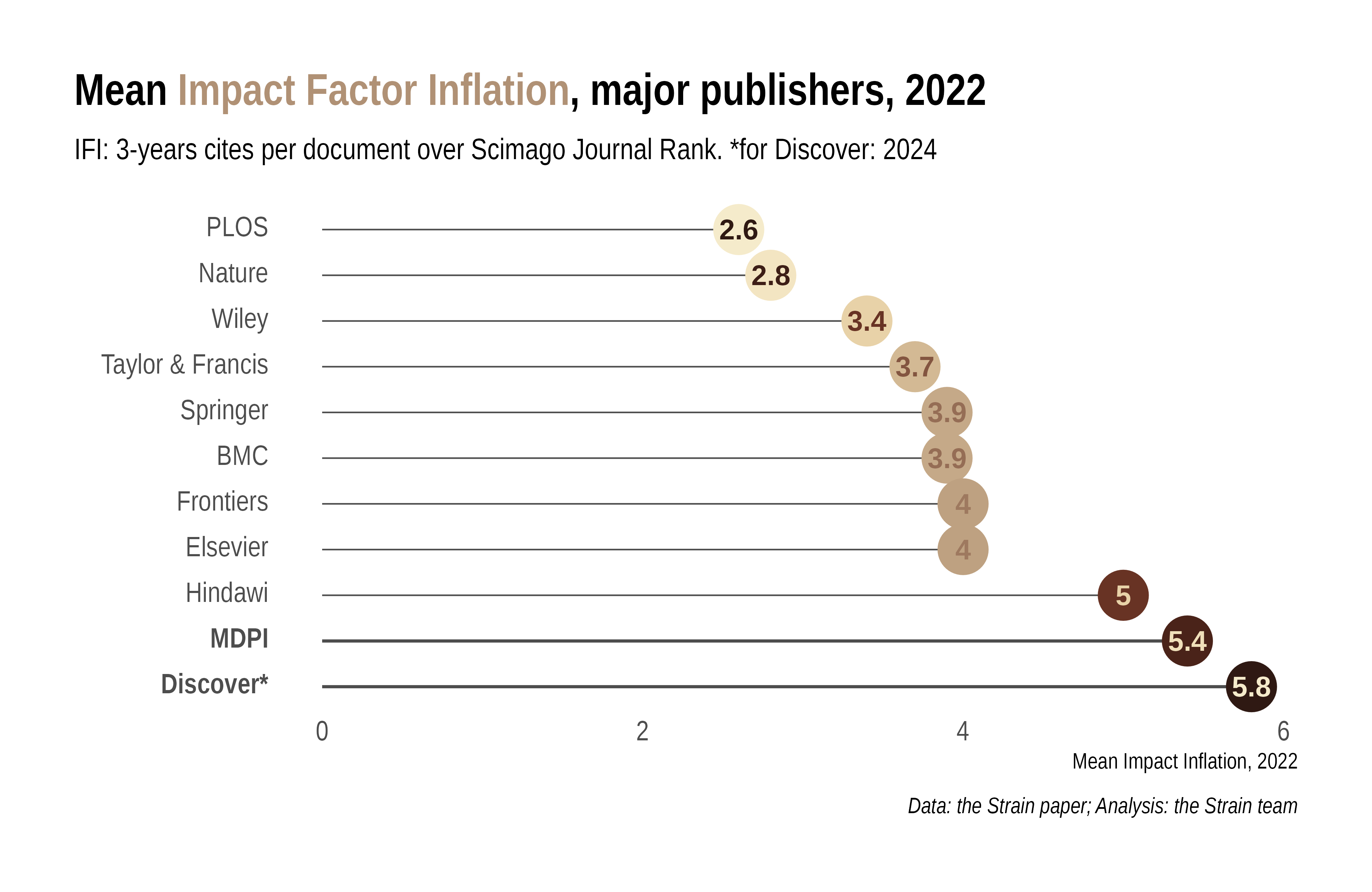Springer Nature Discovers MDPI
Ambiguous one-word journal titles are a Multi-Disciplinary Publishing Institute (MDPI) trademark (“Foods”, “Plants”). In the spirit of “if you can’t beat ’em, join ’em”, Springer Nature has launched a series of journals, the “Discover” series, with near-identical names (Discover Food, Discover Plants). if you don’t believe us, you can try it yourself in our “Guess Who Is Who” mini-game: 👉👉
Why? How? And let’s ask the most important question of all: who will this benefit? It’s certainly not the authors.
Springer Nature Discovers MDPI
To cite this blog post: Paolo Crosetto, Mark Austin Hanson, Daniel Brockington, Pablo Gómez Barreiro. Springer Nature Discovers MDPI. 2025. HAL Id: 05113253, url: https://hal.science/hal-05113253.
For-profit academic publishers say they’re allies to the research community. They provide the venue to publish articles, and only ask a small, insignificant, multi-thousand dollar fee for the trouble. It’s really a steal if you think about it. Researchers get to promote their work, and publishers get to have profit margins rivalling Google and other big tech companies. Everybody wins!
Here at the strain team, we do have a concern though. There has been an unprecedented growth in published academic articles, including the new onslaught of AI-gobbledygook. In our study “The strain on scientific publishing”, we highlighted how certain Gold Open Access for-profit publishers motivate this growth. The most significant outlier by any metric was MDPI, a publisher that has been at the centre of many critiques (see: here, here, here, here, here…).
MDPI is a unique entity, attracting negative attention for their email spam to scientists inviting them to guest edit “special issues.” This has enabled systematic citation gaming across MDPI journals by unsavoury editors, leading to a farcical and extraordinarily fast peer review process, alongside rampant rates of self-citation and impact factor inflation. On the substance of the articles themselves, the lack of scientific rigour in the MDPI editorial process has led to ridiculous articles being published on “tomatoes roaming the fields” among other bunk. Such practices in other publishers resulted in mass article retractions and the end of the Hindawi publishing brand. As a result of these high profile controversies, a number of groups have taken concrete actions to curb the damage done by the model of aggressive recruitment of guest-edited article collections, including refusing to fund the publication charges of such papers (here, here and here).
In a healthy world, other publishers might look at the concern over MDPI and consider how to right the ship. But, dear readers, we do not live in a healthy world. The biggest publishing houses are complicit, and actively contribute, to the current strain (including Elsevier, Frontiers, and more). But we were shocked and dismayed (ok… not shocked, just dismayed) to learn that Springer Nature Portfolio has launched a “Discover” series of journals that seem to deliberately and systematically mimic the MDPI brand.
Publicly, the Discover series journals say they’ll accept any science: “Discover journals… provide a home for all research… our remit is to ensure that all research, validated by peers, has a place in a trusted imprint.” And they’ll do it fast:“[X is] a Discover journal focused on speed of submission and review, service, and integrity.”In other words: “we will publish, fast, anything that you send us so long as it we can call it ‘science.’ It doesn’t need to be useful, you just need to pay us thousands of dollars.”
Sound familiar? Yes, this is precisely what MDPI used to say about its role in the publishing ecosystem. They wanted to publish, fast, anything that was true, under the auspice of ‘letting readers determine its significance.’
But it gets so much worse. Springer Nature Discover journals are literally carbon copying MDPI titles – just pricing them lower to lure scientists in. Below in the Long and Boring Data Appendix we provide the full list of Discover journals, alongside their MDPI equivalents, and the APC charged in 2025. Here we just put one section – Applied Sciences – as an appetizer. Out of 66 Discover journals, 25 have identical names to existing MDPI journals (Viruses - Viruses), 11 differ by one letter (Food – Foods) and 22 more have looser but clearly distinguishable similarity (Computing – Computers). That’s 58 copycat journal titles out of 66 for you.
And, Discover, like MDPI, are now sending unsolicited mails to academics inviting them to head up special collections (aka Special Issues). We know, because we received one such, generous, invitation.
It seems that Springer Nature has Discovered MDPI.
Why does this matter?
Well, publishers claim to be filling a market need. While this siren call sounds sweet and inviting, the reality behind it has been much darker. The rush to produce more work in special issues has produced an avalanche of poor quality work. It also matters because the one thing that MDPI had going for it was its transparency. Footling arounda on the MDPI website, their rejection rates, turn around times, and special issue collections were easily visible. The Discover series demonstrates no such transparency, making it much harder to hold them to account. This muddies the waters of genuine research fields, and undermines public trust in science.
We need to remember that Springer Nature has previously demonstrated a keen interest in generating quantity, rather than quality. In 2011 it launched Scientific Reports, which has become the largest Open Access megajournal ever, overtaking PLOS One back in 2016. What is especially salient there is that PLOS One stated publicly that its editorial rigour was uncompromising, and part of the drop in its publications was a lower acceptance rate. PLOS One had further recruited 3000 editorial board members to handle the then ~5000 submissions per month, and introduced new article triaging measures before peer review, helping to handle the immense volume of submissions while maintaining editorial quality. We cannot see evidence of similar behaviour in Scientific Reports.
And the worst thing of all? This will work. The Springer Nature brand will protect Discover. Springer Nature will allow Discover to prosper at the same time as the services it offers are an expensive distraction. Scientists will turn to Discover journals, as the service offers what they are looking for – a reputable open access publication for a small fee. Indeed, many already are: the Discover series has grown from 10 journals in 2020 to 66 in June 2025, collectively publishing 2308 papers in 2020, but a whole 5352 in 2024 – so far, we have counted 4739 papers published from January to May in 2025 alone, so this number seems likely to double.
Apart from the literally identical names, how similar are Discover journals to their MDPI twins? It’s a mixed bag.
In terms of growth, newly-minted Discover journals show the same explosive trajectory of MDPI, circa 2018-19. Overall, the Discover franchise grew by 324% between 2023 and 2024 (635% at Discover Food, 530% at Discover Environment. 1017% at Discover Sustainability – see the Long and Boring Data Appendix for more). The subset of Discover journals that has an Impact Factor, as a whole, also sport the same IFIb as the MDPI journals they took their titles from (2024 mean IFI: Discover = 5.6, MDPI = 5.8, while PLOS = 3.0, BioMed Central = 3.8 – and again, IFI of all Discover journals and their MDPI counterparts in the LBDA).
Still, the Discover series is not overly reliant on Special Issues, yet. This might soon change. Anecdotally, we observe a surge in emails inviting scientists to edit collections – this is the name given to guest-edited special issues at Discover. We know, because one of us received one such email. Also, the number of open special issues seem to have had an uptick recently – overall, there are 1255 open SI at Discover, about 19 per journal on average (Applied Sciences: 160; Sustainability: 113 – see the LBDA). If we assume about 5 papers per SI, this amounts to about 6 thousand more papers to be expected via the guest-edited model in 2025 and early 2026. We wrote a whole study on how special issue invitations are an engine for journal growth. In that work, Springer Nature’s main strategy was to open more total journals to drive growth in total articles published, rivalling the growth seen by MDPI’s special issue engine. To see Springer Nature both opening a whole slew of new journals under the Discover brand, alongside an aggressive special issue push, is distressing. Note: 36/66 Discover journals popped up since 2024 (see the LBDA).
Discover also displays turnaround times more in line with the bulk of the scientific publishing industry (2024 mean: 131 days from submission to acceptance); this is a far cry from other for-profit OA publishers known for their heavy-handed choices in the speed-accuracy trade-off (2022 mean of 37 days for MDPI and 72 days for Frontiers). But we previously showed that special issues tend to have more rapid turnaround times compared to normal articles, and the bulk of Discover’s growth has happened in just the last year alongside this special issue push, so we’d encourage everyone to watch this space closely.
So, Discover has the same names, same business model, but not exactly (or not yet) the same metrics on all fronts.
What can be done about this?
Let’s start by collectively doing what we can:
First, think twice before sending your work to a for-profit publisher. In biological sciences there are journal lists like DAFNEE that aggregate society and not-for-profit journals. Services like PeerCommunityIn review and publish work FREE OF CHARGE, with journal sections covering the life sciences and more. Invest your APCs back into science.
Second, IGNORE ALL REQUESTS from these publishers. Do not respond to requests to review. Do not respond to requests to head up special collections. Do not become an editor in these journals. Do not subsidise their business model.c
Third, notify your Director of Research. Ask them to tell to their boss, and ask them to alert key funders (i.e. universities and research councils). Each group will find its own tolerance for action, but time and again it has been shown that change happens when the funders take action.
And, of course:
Fourth, embrace the ridiculousness of the for-profit publishing landscape, try our “Springer Nature or MDPI” mini-games and let’s have a chat on the Bluesky #ResearchIntegrity feed.
Let’s stop falling for the same (in this case, literally the same) old tricks. Let’s stop wasting money on journals we do not need.
~ The strain team.
Erratum (June 12th 2025)
The data we use for turnaround times and to assess the growth of Discover journals come from a web scrape we made on June 1st, 2025 (see Data Sources below for more details). There was a bug in the scrape: for the 4 biggest Discover journals that had published >1,000 articles over all years (Applied Sciences, Oncology, Nano and Sustainability), the script interpreted the comma separating the thousands as “not a number” and hence scraped only a handful of articles (for instance, 6,543 was interpreted as “6”). As a result, our earlier data was missing most turnaround time data for the four biggest Discover journals.
We found the bug, and reran the scrape for these 4 journals specifically on June 11th, 2025. This led to changes in most of the aggregate data on TATs and number of papers.
Adding these journals in, the average turnaround time for Discover in 2024 falls to 131 days (from 140). The overall growth rate of Discover journals falls to 324% (from 460%). Also, we had claimed there existed 5 Discover journals in 2020 – there were 10 – and the overall number of papers published by Discover in recent years nearly doubled.
Our general claims are unaffected by these changes.
This correction did not impact in any way Impact Inflation numbers (that come from Scimago), APCs and the names of journals (that come from a manual perusal of Discover websites).
Addendum (June 12th 2025)
While we were correcting our scraping problem, we took the opportunity to add data about the number of open special issues (they are called collections at Discover). We hence added a data table detailing the recent number of papers and the number of open SIs at Discover, and some lines of comment in the main text. We also added a table showing the timeline of journal creation – showing how a big expansion in Discover titles happened in 2024, as MDPI was slowing down its growth, and that about half of Discover journals were born since 2024, 5/6 since 2020.
Long and Boring Data Appendix
All Discover journal and their MDPI homonyms
Number of articles and recent growth at Discover
Number of Open Special issue at Discover
Impact Factor Inflation at Discover and their MDPI homonyms
Turnaround times at Discover
Timeline of journal creation at Discover
Data Sources
| Data | Source | Date retrieved |
|---|---|---|
| Names of the journals | Manual perusal of Discover website | May 2025 |
| APCs | Manual perusal of Discover website | May 2025 |
| Impact Inflation | Own computation based on Scimago 2024 data dump | May 2025 |
| Turnaround Times | For Discover: web scrape of individual articles For all others: The Strain on Scientific Publishing |
Discover: June 1st and June 11th, 2025 All others: August 2023 |
| N papers | For Discover: web scrape of individual articles For all others: The Strain on Scientific Publishing |
Discover: June 1st and June 11th, 2025 All others: August 2023 |
| N open Special Issues | Scrape of Discover website | June 11th, 2025 |












